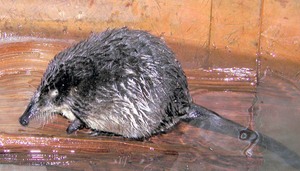Introduction
The Russian desman (Desmana moschata) is a poorly known member of the family Talpidae. Together with the Iberian desman (Galemys pyrenaicus), they constitute the two extant species of the tribe Desmanini. The current geographic range of the Russian desman comprises the Volga, Don and Ural River basins in western Russia, Kazakhstan and Europeаn Russia, and it is currently listed as critically endangered (M. Rutovskaya, Gazzard, and Turvey 2023).
Despite the shared evolutionary history between both desmans, they occupy different ecological niches. The Russian desman inhabits oxbow lakes and slow-moving rivers with a depth of 2-6 m with rich water-marsh vegetation, bushes and primary forests along the banks, and with high macroinvertebrate abundance (M. Rutovskaya, Gazzard, and Turvey 2023; M. V. Rutovskaya et al. 2020). In contrast, the Iberian desman is restricted to fast-flowing, shallow and well-oxygenated waters in mountainous regions of the Iberian Peninsula (Nores 2007; Quaglietta et al. 2024).
Unlike most Talpidae species, which are fossorial or semi-fossorial, desmans exhibit a semi-aquatic lifestyle. Accordingly, they present several convergently adaptive traits to this ecological niche, including large webbed hindfeet, a laterally compressed tail, double-layered fur, and a mobile prehensile snout (Wilson and Mittermeier 2018), and, consequently, modifications in thermoregulation and olfactory physiology (Martinez et al. 2020).
Methods
A muscle sample was collected from a male individual of a Russian desman, from the Spassky district of the Ryazan region (Russia) captured in 2008 and maintained in captivity until its death in July 2015. The tissue was used for total DNA extraction using the Qiagen MagAttract HMW DNA extraction kit (Dobra). Whole genome sequencing was conducted at Macrogen Inc (Korea), using a Truseq Nano DNA Illumina library preparation kit, followed by sequencing of paired-end (2 × 150 bp) reads using a NovaSeq6000 Illumina machine. The raw sequencing outputs were quality filtered and trimmed of adapters using Trimmomatic v.0.38 (Bolger, Lohse, and Usadel 2014). Whole genome de novo assembly was produced using Abyss2 (Jackman et al. 2017) specifying a 105 k-mer length, estimated using KmerGenie v.1.7051 (Chikhi and Medvedev 2014).
Results
The genome assembly yielded a total sequence length of 2.09Gbp over 1,670,778 scaffolds, and an N50 length of 64,508bp.
Data availability
Raw and assembled data is publicly available via European Nucleotide Archive (ENA):
Raw genome data
https://www.ebi.ac.uk/ena/browser/view/ERR13337211
Assembled genome
https://www.ebi.ac.uk/ena/browser/view/GCA_965120235
Funding
Foundation for Science and Technology (FCT) funded SS through the grant 2021.07072.BD (https://doi.org/10.54499/2021.07072.BD). Foundation for Science and Technology (FCT) supported AGS [2023.07625.CEECIND] and EF (CEECINST/00027/2021/CP2789/CT0003 and DOI identifier https://doi.org/10.54499/CEECINST/00027/2021/CP2789/CT0003).

